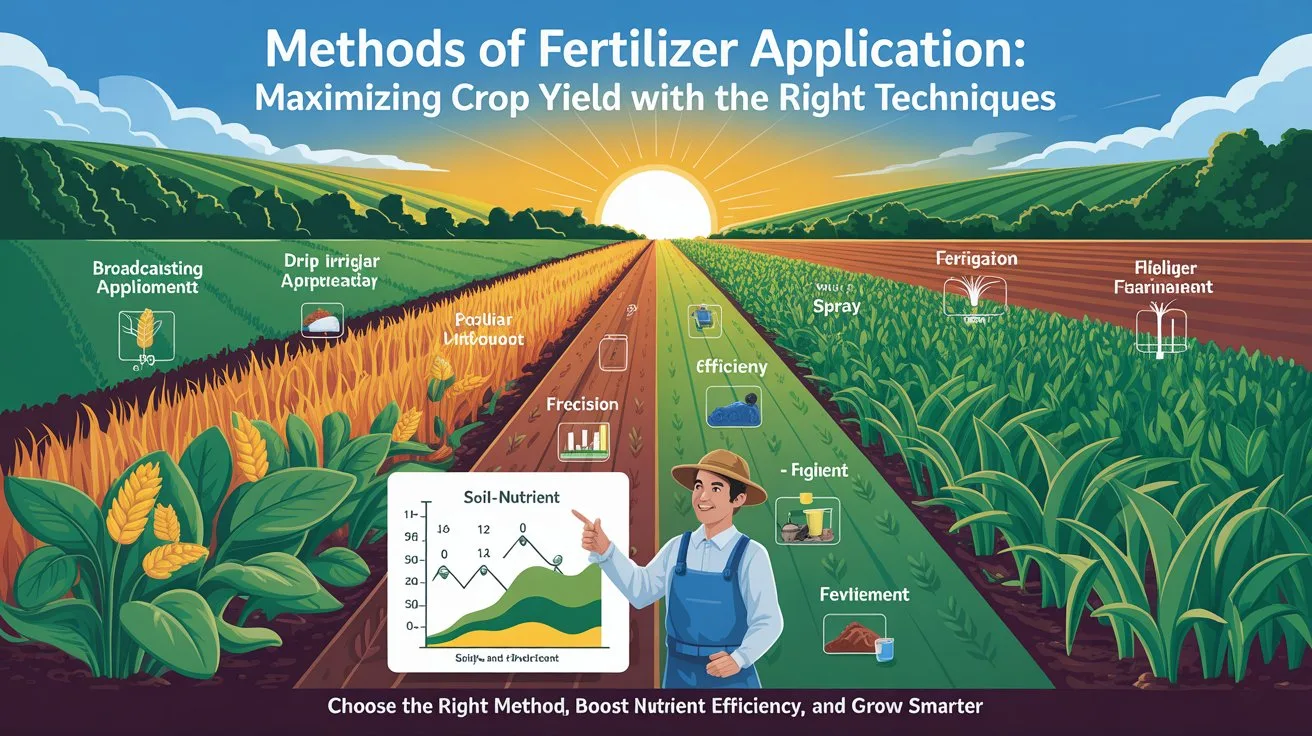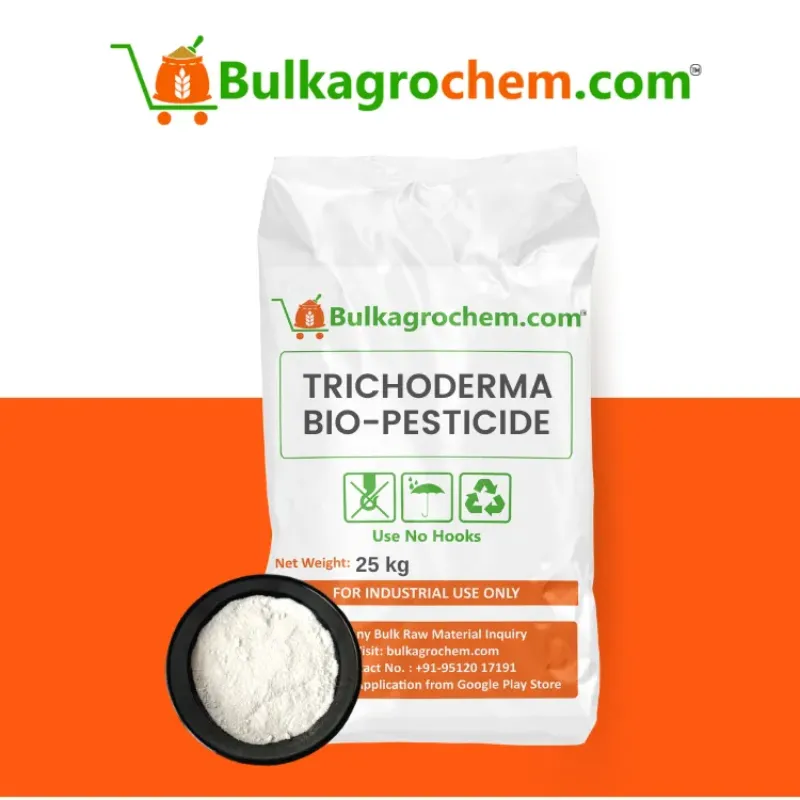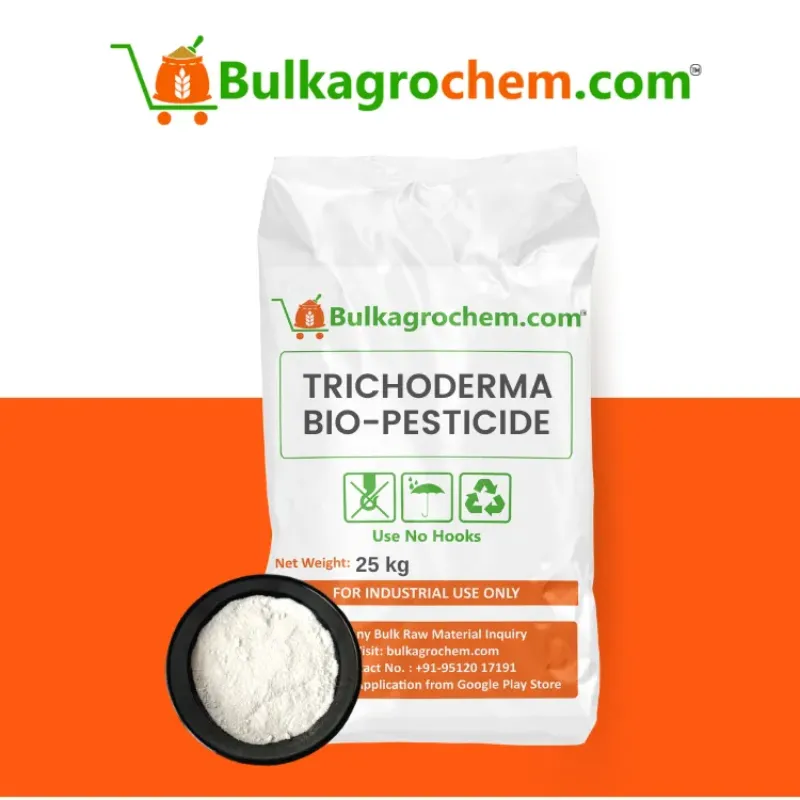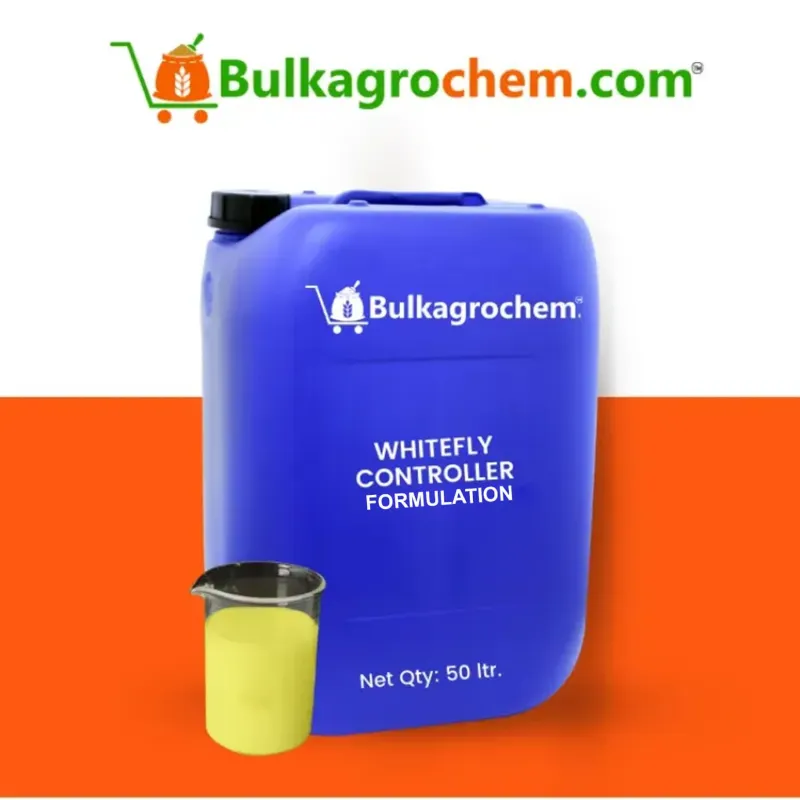Selecting an appropriate fertilizer application technique is important to maximize crop yield and healthy growth. Different approaches of fertilizer application are taken, based on crop type, soil state, and then fertilizer type. Banding fertilizer is one common application technique; applying fertilizer in bands, located adjacent to the root zone near the plant roots. When done correctly fertilized nutrients will be readily available to plants while minimizing nutrient loss due to evaporation or runoff.
Basal application fertilizer is another common application approach, applying fertilizers to soil before planting, or early in the plant growth cycle. This can help provide the right nutrients in a steady manner as your crops begin to grow using initial vegetative growth to increase root growth and subsequently the crop yield. Furthermore, when the application is done correctly, each of these approaches can help manage the ultimate nutrient uptake by the crop and diminishing fertilizer waste, giving your crops the best nutrient opportunity to grow and maximize your crop's productivity.
Understanding the Importance of Fertilizer Application
The application of fertilizer is central to promoting healthy plants and increasing crop yields. If well applied, fertilizers will provide the nutrients for plants to use efficiently and ensure a strong root system, good plant development and high levels of productivity. Fertilizer supplies essential nutrients such as nitrogen, phosphorus and potassium (NPK), among others, plus micronutrients, which are required for metabolic reactions in plants to stay alive and healthy. If the application of fertilizer is not done properly, plants agricultural productivity will be poorly affected by lack of access to the nutrients needed for good crop growth.
Why Proper Fertilizer Application Matters
Proper application of fertilizers makes a difference between crops obtaining nutrients at the correct time and losing nutrient through non-efficient and incorrect application. Non-efficient and incorrect application could result in waste of nutrients, pollution to the environment and impact plants. For example, excess fertilizer applied to crops can burn plant leaves. On the otherhand, under-fertilized plants often become stunted. Proper timing, placement and rate of application of a fertilizer affect the efficiency of using resources and therefore determining both economic and environmental benefits. It is important to note that sustainable practices in agriculture like runoff reduction of fertilizers are vital to reduce agricultural footprint on the environment.
Different Methods of Fertilizer Application
There are several ways to apply fertilizer, depending on type of crop, other growing conditions and soil. The most common ways includes the following:
- Banding Method of Fertilizer Application: Banding fertilizer refers to the process of applying fertilizer in narrow bands close to the crop root zone, either at planting time, or during the growing season. Banding minimizes loss of nutrients and can also enhance the fertilizer placement relative to the plant where it will be best available to the crop.
- Basal Application Fertilizer: Similarly, basal application refers to the process of applying fertilizer to soil at or prior to planting, or early in the growing season. By using basal application, crops are able to access a nutrient supply from the start of establishment without restrictions from altered rooting patterns, which can occur if growing outside of their ideal planting window.
- Foliar Application: Fertilizer is sprayed directly on the leaves of plants. Once applied, the fertilizer is absorbed directly through the leaf surface. Calcium nitrate is one of the most commonly foliar applied fertilizers. Foliar application is usually applied in all crops, particularly for quick corrections of micronutrient absorption needs, or if the nutrient deficiency symptoms are too severe to correct adequately by any of the other application methods listed here.
- Side Dressed examples: Fertilizer is applied down the sides of growing plants after they are established, usually in the growing season. Side dressing helps add all kinds of nutrients at various plant growth stages - flowering, fruiting, etc.
Key Considerations When Choosing Fertilizer Application Techniques
When selecting a fertilizer application method, you should consider several factors to ensure optimal results:
- Soil Type and Characterization: Different soils have different capacities to hold nutrients. In sunny soils the nutrient holding capacity might mean more frequent applications, while heavier clay type soils may be more beneficial of slow-release types of fertilizers.
- Crop Type: Different crops have different nutritional needs. For example, a vegetable; tomatoes may need higher levels of nitrogen in their growth phase, while their fruit trees require a balanced NPK mix during their growing phase.
- Climate and Seasonality: The timing of fertilizer applications will depend on climate. In wetter climatic areas, slow-release fertilizers may provide a better means of preventing nutrient leaching, while in a dry climatic environment applying nutrients via foliar feeding can help ensure the plants are fed within their typical plant resource needs .
- Environmental consideration: Sustainable agricultural practices should apply annoying to minimize fertilizer runoff and excess application of resources. Other techniques such as banding or using organic or slow-release fertilizers will help minimize the environmental risk of fertilizers.
Banding Fertilizer Method: Precision for Optimal Nutrient Uptake
What is Banding Fertilizer?
Banding is a method of fertilizer application that involves placing fertilizer in localized bands close to the plant roots either at planting or during the growing season. Banding refers to placing fertilizer in bands or concentrated zones, whereas broadcasting means spreading fertilizer across the surface of the soil. Banding is more efficient because it places the nutrients where the plant roots can use it most effectively, since banded fertilizer is less likely to become wasted, the package of fertilizer will remain next to the plant roots, and allow for maximum nutrient availability for plant growth.
Benefits of Banding Fertilizer
- Effective Nutrient Use: Banding offers more precision in nutrient placement which leads to the best efficiency in nutrient uptake. Plants have better availability of the nutrients and there will be less loss of nutrients through leaching or evaporation.
- Better Plant growth: By applying nutrients close to the root zone, greater root development occurs and the plants will grow healthier overall. The nutrients placed close to the root zone enables the plants to better utilize that area through root expansion and tap into more nutrients and water. This is particularly important in the early stages of plant growth.
- Better Fertilizer Use Efficiency: Because banding places fertilizer exactly where it is needed in a concentrated area, there would be less loss to leaching or runoff. It is more environmentally friendly in that there will not be certain losses to a water source nearby as can happen when broadcasting fertilizer or become airborne when applied as a side-dressed fertilizer.
- Ideal Option for Row Crops or Large Fields: Banding is particularly good for row crops such as corn, wheat and soybeans where the crops are evenly space. Furthermore, banding also allows for a larger chance of the entire fertilizer being utilized efficiently and also provides for a better chance of uniform growth throughout the field.
Best Practices for Using the Banding Fertilizer Method
- Choose the Correct Equipment: In order to implement such a method of banding, you will need specialized equipment (a planter or fertilizer applicator) to offer a fertilizer in narrow bands. Your equipment will need proper calibration for the depth and width of your application.
- Apply at the Correct Times: The use of banding can occur at planting time, as well as a mid-season application. For most crops, a fertilizer application will occur at planting time, providing nutrients for young plants immediately. Nutrients can be applied mid-season, as needed, according a specific growth stages.
- Apply at the Correct Depth: Fertilizer should be applied 2 to 3 inches below the surface so roots can properly take up nutrients and be provided if necessary. If a fertilizer is applied too deep, roots may not be able to take up the nutrients. If a fertilizer is applied too shallow, nutrients may be lost to evaporation or runoff.
Basal Application Fertilizer: Laying the Foundation for Growth
Basal application of fertilizer is a fundamental technique for supporting the early growth and development of crops. By laying the foundation with the right nutrients, this method helps plants thrive, supporting higher yields and long-term soil health. When used correctly, basal fertilization ensures that plants start strong and are well-equipped to grow and produce bountiful harvests.
What is Basal Application of Fertilizer?
Basal application of fertilizer refers to the practice of applying fertilizer to the soil before planting crops. It is typically done at the beginning of the planting season to ensure that the soil has an adequate supply of essential nutrients when seeds are sown or transplants are placed in the ground. Basal fertilizers are generally applied to the entire field or garden bed, either by broadcasting or incorporating them into the soil. This ensures that the plants have the nutrients they need right from the start of their growth cycle.
Benefits of Basal Fertilizer Application
- Improved Initial Plant Growth: By applying fertilizer before planting, plants can access the nutrients they need for early development. This leads to strong seedlings and better root establishment, which are crucial for the plant's future growth.
- Enhanced Nutrient Availability: Basal fertilizers are usually incorporated into the soil, which allows nutrients to be readily available when plants begin their growth. It helps the plants establish their roots in nutrient-rich soil, supporting their development and early-stage growth.
- Long-Term Soil Fertility: Basal application sets up a long-term foundation for plant nutrition. With the fertilizer already in place, crops will benefit from a steady supply of nutrients as they grow, reducing the need for frequent reapplications and supporting long-term soil fertility.
- Increased Yields: By ensuring that plants have a good start with adequate nutrients, basal fertilization can help to increase overall crop yields. Plants that are well-nourished from the start tend to grow faster, produce more fruit, and are generally healthier.
How to Apply Basal Fertilizer Effectivel
- Choose the Right Fertilizer: The first step in basal fertilizer application is selecting the right type of fertilizer for your plants. It is important to match the fertilizer's nutrient composition with the needs of your soil and plants. This may require conducting a soil test to determine nutrient deficiencies.
- Even Distribution: Apply the fertilizer evenly across the planting area. You can use broadcast spreaders for larger areas or manually sprinkle the fertilizer for smaller garden beds. Make sure the fertilizer is spread uniformly to ensure that all plants have equal access to nutrients.
- Incorporating Fertilizer into the Soil: After application, incorporate the fertilizer into the soil using tools such as a rake or tiller. This allows the fertilizer to mix with the soil and helps with nutrient absorption by plant roots. In some cases, you can apply basal fertilizer and leave it on the surface before planting, but mixing it into the soil can enhance its effectiveness.
- Watering After Application: After applying and incorporating the fertilizer, water the soil thoroughly. This helps activate the fertilizer and ensures that it reaches the root zone where it can be absorbed by the plants. Adequate watering is essential to maximize the effectiveness of basal fertilizers.
Combining Fertilizer Methods: Enhancing Crop Performance
Fertilizer application methods play a crucial role in maximizing crop performance. By strategically combining different methods such as banding fertilizer and basal application fertilizer, farmers can provide crops with a balanced supply of nutrients that meets both immediate and long-term needs. These combined techniques improve soil health, increase nutrient uptake efficiency, and optimize crop yields, resulting in healthier, more productive crops.
When to Use Banding and Basal Fertilizer Together
In certain agricultural practices, combining the banding fertilizer method with basal application fertilizer can optimize nutrient delivery to crops. Banding fertilizer applies nutrients directly to the soil near the roots, while basal application ensures a comprehensive nutrient supply throughout the entire growing medium. This combination is especially effective for crops that require a quick nutrient boost at the beginning of the growing season, along with a sustained nutrient supply for longer-term development.
- Immediate Nutrient Access: Banding fertilizer allows plants to access nutrients quickly, providing an initial growth surge.
- Sustained Nutrient Availability: Basal application provides a steady supply of essential nutrients over time.
- Customized Growth: Combining both methods ensures that crops get the right nutrients at different growth stages, enhancing overall performance.
Choosing Between Banding and Basal Application
When choosing between banding fertilizer and basal application fertilizer, consider the plant’s growth stage and specific nutrient needs.
- Banding Fertilizer: Ideal for crops that need rapid root uptake during early stages of growth or when precision in nutrient placement is required. This method is particularly beneficial for row crops and plants that are sensitive to nutrient concentration in the soil.
- Basal Fertilizer: Best for crops that require a steady nutrient supply throughout their growth cycle. It’s perfect for starting off crops and laying a foundation of nutrients for the entire growing season, especially in fields or gardens where soil deficiencies need to be addressed.
Advanced Fertilization Techniques for Better Crop Yield
Advanced fertilization techniques such as fertigation (fertilizer application through irrigation) and foliar feeding can enhance the effectiveness of basal application fertilizer and banding fertilizer method. These techniques work in synergy to provide the right nutrients at the right time and in the right quantity.
- Fertigation: Fertilizer is applied through the irrigation system, ensuring even nutrient distribution to plants while minimizing runoff and waste. This technique works well when combined with basal application to supplement nutrient uptake.
- Foliar Feeding: Nutrients are applied directly to the leaves, allowing for fast nutrient absorption. This method complements banding and basal applications by addressing immediate nutrient deficiencies when plants are actively growing.
FAQs
Q1. What is the difference between banding and basal fertilizer application?
Banding fertilizer involves placing concentrated fertilizer in bands near the plant roots, while basal application fertilizer is applied evenly across the soil to provide a steady nutrient supply throughout the growing season.
Q2. When should I apply basal fertilizer for optimal crop growth?
Basal fertilizer is best applied at the beginning of the planting season or during soil preparation, ensuring that crops have access to nutrients throughout their growth stages.
Q3. Can I combine the banding fertilizer method with other techniques?
Yes, combining banding fertilizer with other methods, such as broadcasting or side dressing, can enhance nutrient availability and improve crop performance when used at the right times.
Q4. How does the banding fertilizer method improve nutrient uptake?
The banding fertilizer method places nutrients directly where plant roots are most active, which allows for efficient nutrient absorption, leading to quicker plant establishment and better growth.
Q5. Is basal fertilizer application suitable for all crops?
Basal fertilizer application is widely used for many crops, particularly for those that require a steady supply of nutrients, such as fruits, vegetables, and grains. However, certain crops may have specific fertilizer needs that should be considered.
Conclusion: Maximize Your Crop’s Potential with the Right Fertilizer Application Method
Choosing the right fertilizer application method is essential to maximizing your crop's potential. Banding fertilizer and basal application fertilizer both offer distinct advantages when applied correctly. Banding delivers concentrated nutrients where plant roots need them most, while basal application ensures a steady supply of nutrients throughout the growing season.
By understanding the benefits of each method and considering factors such as soil type, crop needs, and environmental conditions, you can optimize fertilizer use and boost crop yields. Experimenting with different techniques and combining methods when necessary can lead to healthier plants and a more successful harvest. Whether you choose banding, basal application, or a combination of both, proper fertilizer application is key to enhancing soil fertility and achieving the best possible crop performance.




